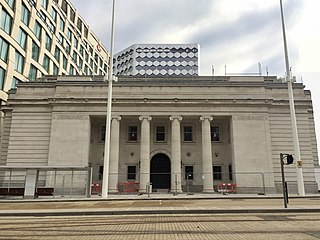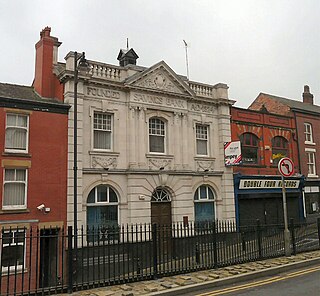Related Research Articles

The Federal Deposit Insurance Corporation (FDIC) is a United States government corporation supplying deposit insurance to depositors in American commercial banks and savings banks. The FDIC was created by the Banking Act of 1933, enacted during the Great Depression to restore trust in the American banking system. More than one-third of banks failed in the years before the FDIC's creation, and bank runs were common. The insurance limit was initially US$2,500 per ownership category, and this has been increased several times over the years. Since the enactment of the Dodd–Frank Wall Street Reform and Consumer Protection Act in 2010, the FDIC insures deposits in member banks up to $250,000 per ownership category. FDIC insurance is backed by the full faith and credit of the government of the United States, and according to the FDIC, "since its start in 1933 no depositor has ever lost a penny of FDIC-insured funds".

Airdrie Savings Bank was a small commercial bank operation in the Lanarkshire area of Scotland. It ran three branches throughout the area, with its head office in Airdrie at the time of the announcement of its closure. Total assets of the bank at 31 October 2013 were £158 million with a reported loss of £267,000. In January 2017, the bank announced it would begin closure proceedings on 28 April of that year.

Yorkshire Bank is a trading name used by Clydesdale Bank plc for its retail banking operations in England.

The Trustee Savings Bank (TSB) was a British financial institution. Trustee savings banks originated to accept savings deposits from those with moderate means. Their shares were not traded on the stock market but, unlike mutually held building societies, depositors had no voting rights; nor did they have the power to direct the financial and managerial goals of the organisation. Directors were appointed as trustees on a voluntary basis. The first trustee savings bank was established by Rev. Henry Duncan of Ruthwell in Dumfriesshire for his poorest parishioners in 1810, with its sole purpose being to serve the local people in the community. Between 1970 and 1985, the various trustee savings banks in the United Kingdom were amalgamated into a single institution named TSB Group plc, which was floated on the London Stock Exchange. In 1995, the TSB merged with Lloyds Bank to form Lloyds TSB, at that point the largest bank in the UK by market share and the second-largest by market capitalisation.
The Trustee Savings Banks Association was established in Manchester in 1887. However, throughout its history the Trustee Savings Banks Association failed to act as central provider of administrative functions to small independent savings banks.

The Birmingham Municipal Bank was a savings bank in the city of Birmingham, England. It was created as the Birmingham Corporation Savings Bank by a 1916 Act of Parliament on a temporary basis and replaced by the Birmingham Municipal Bank in 1919. In 1976 it converted into a trustee savings bank.

The Freedman's Saving and Trust Company, known as the Freedman's Savings Bank, was a private savings bank chartered by the U.S. Congress on March 3, 1865, to collect deposits from the newly emancipated communities. The bank opened 37 branches across 17 states and Washington DC within 7 years and collected funds from over 67,000 depositors. At the height of its success, the Freedman's Savings Bank held assets worth more than $3.7 million in 1872 dollars, which translates to approximately $80 million in 2021.

A bank is a financial institution that accepts deposits from the public and creates a demand deposit while simultaneously making loans. Lending activities can be directly performed by the bank or indirectly through capital markets.
Reserve Requirements for Depository Institutions is a Federal Reserve regulation governing the reserves that banks and credit unions keep to satisfy depositor withdrawals. Although the regulation still requires banks to report the aggregate balances of their deposit accounts to the Federal Reserve, most of its provisions are inactive as a result of policy changes during the COVID-19 pandemic.
Formed in 1836, the Edinburgh Savings Bank was successor to the Edinburgh Bank for Savings, which dated back to 1814. Although formed after the Ruthwell Savings Bank, the Edinburgh provided the model for future savings banks. By the end of World War two, it was second in size only to the Glasgow Savings Bank. In 1975, Edinburgh merged with three other Scottish savings banks to form an enlarged South of Scotland TSB.
The Aberdeen Savings Bank was a Scottish savings bank. It was formed in 1815 and reconstituted in 1845 under the 1835 Savings Act. It remained a small bank until the interwar period when a series of acquisitions made it grow to fifth in size in 1944. It became one of Scotland's four regional savings banks in 1975. In 1983, it became a part of TSB Scotland.

The Stockport Savings Bank was formed in 1824 in Stockport, then in the county of Cheshire. It was run on a conservative basis but remained independent until 1975 when it became part of TSB North West Central, following the Page Committee’s recommendation that the TSBs be grouped into larger regional entities.
The Sheffield Savings Bank was formed in Sheffield Yorkshire in 1819. For much of its early years it was run conservatively, briefly experimenting with local branches in the 1850s. In the twentieth century, branches were reintroduced, both in the city and outlying towns. By 1944 it was twelfth nationally by size of funds. In 1976, the Bank merged to form part of TSB Yorkshire & Lincoln.
The Perth Savings Bank was established in Perth, Scotland, in 1815. In 1975, it merged to form part of the Trustee Savings Bank of Tayside and Central Scotland.
The West Midland Savings Bank had its roots in Shrewsbury, Shropshire and the merger of its two town banks in 1839 to become the Salop County and Abbey Savings Bank. It remained one of many small savings banks in the Border Counties until the early twentieth century when it led a series of amalgamations. In recognition of its wider coverage, it became the West Midlands TSB in 1937. In 1975 it merged to form the TSB of Wales and Border Counties.
The Liverpool Savings Bank was a bank founded in 1815 in Liverpool, United Kingdom. By 1956, it had grown to be the fourth largest savings bank in the country. The bank became part of the TSB of Mid-Lancashire & Merseyside.
The Manchester and Salford Savings Bank opened in 1818 in Manchester. For a long period, it was the third largest savings bank in the country and at one stage, the largest savings bank in England. Following the Trustee Savings Bank Act of 1975, the Bank merged with seven other local savings banks to form the TSB North West Central.
St Martin’s Place Bank was founded in London in 1816 and for much of the nineteenth century was the leading savings bank in the country. However, it went into decline in the latter part of the century and, in 1896, declined to accept the recommendations of the independent Inspection Committee. The Bank closed its doors and transferred the depositors’ funds to the Post Office.
The London Savings Bank was a product of a 1916 merger between the London Provident Institution (1816), the Bloomsbury Savings Bank (1817) and the Lambeth Savings Bank (1818). In 1942 the Finsbury and City of London Savings Bank amalgamated with the London Savings Bank. In 1971, the London Savings Bank became part of the London and South Eastern TSB, which in turn became part of TSB South East.
The York County Savings Bank was a savings bank based in York, in England. At one time, it was the third largest savings bank in the country.